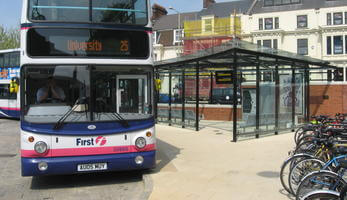Providing a high-quality bus/rail interchange
Thematic areas
Collective passenger transport & shared mobility
- Ride sharing
- Car sharing
- Bike sharing
- Accessibility
- Intermodality
- Service improvements
Summary
Improving the frequency of bus services from the railway station to Norwich city centre was seen as an effective way of improving the modal share of public transport.
Implementing sustainable mobility
Norwich rail station is located 1 km from the city’s commercial and retail centre. Lack of easy access from the station to connecting bus services was identified as preventing the use of local rail services for travel to work, shopping and leisure activities. Public consultations had consistently demonstrated public demand for better linkages between the railway station and the city centre, and for better signage of bus services.
The principal objectives of the measure were to:
- redesign the space outside the railway station to improve the location of the bus stop on the station forecourt;
- improve access arrangements for buses currently stopping on the road so that these stops could be located closer to the railway station forecourt;
- provide high-quality waiting facilities and real-time passenger information on the station forecourt with convenient pedestrian links between the station building, the waiting facility and the bus stops on the forecourt and the adjacent road; and
- provide covered bicycle parking facilities, as requested by the public and interest groups.
Progress
Work on obtaining planning and railway industry consent commenced in April 2005 and continued until October 2006. On-site work commenced in January 2007 and was completed in early April 2007. The existing bus stops at the railway station were moved together, making it easy to catch any bus to the city centre, whether from the station forecourt or from the adjacent Thorpe Road. This work involved building a new bus stop lay-by on the south side of Thorpe Road and a large sheltered waiting area between the bus stops on the station forecourt and Thorpe Road. Within the waiting area there is seating for 15 people and a dedicated wheelchair space, a ticket vending machine for the pre-purchase of bus tickets, and a display screen providing real-time information on bus arrival and departure times.
Outcomes
The introduction of new routes serving the railway station and the extension of existing services to the station contributed to an increase in the number of bus passenger journeys to and from the railway station.
An on-street interview survey found that:
- 34 percent of respondents thought that the frequency of buses to the city centre had improved;
- 98 percent of respondents were satisfied with the quality of the new facilities, and 42 percent were very satisfied;
- 80 percent of respondents thought that physical access to the bus stops had improved;
- 68 percent of respondents said that they felt safer when using the new interchange; and
- the frequency of bus use amongst those surveyed had increased.









